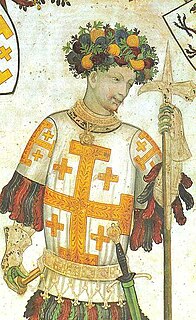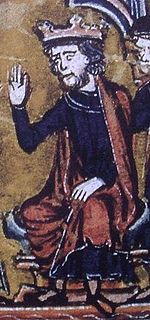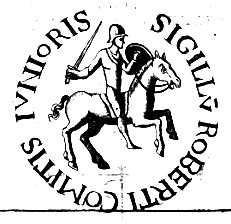Related Research Articles

The Kingdom of Jerusalem, also known as the Latin Kingdom of Jerusalem, was a Crusader state established in the Southern Levant by Godfrey of Bouillon in 1099 after the First Crusade. The kingdom lasted nearly two hundred years, from 1099 until 1291 when its last remaining possession, Acre, was destroyed by the Mamluks. Its history is divided into two distinct periods. The First Kingdom of Jerusalem lasted from 1099 to 1187 before being almost entirely overrun by Saladin. Following the Third Crusade, the kingdom was re-established in Acre in 1192, and lasted until the city's destruction in 1291. This second kingdom is sometimes called the Second Kingdom of Jerusalem or the Kingdom of Acre, after its new capital. Acre remained the capital, except for the two decades which followed Frederick II of Hohenstaufen regaining the city of Jerusalem from the Ayyubids in the Sixth Crusade through diplomacy. The vast majority of the crusaders who established and settled the Kingdom of Jerusalem were from the Kingdom of France, as were the knights and soldiers who made up the bulk of the steady flow of reinforcements throughout the two-hundred-year span of its existence. Its rulers and elite were therefore of French origin. The French Crusaders also brought the French language to the Levant, thus making Old French the lingua franca of the Crusader states.

Year 1099 (MXCIX) was a common year starting on Saturday of the Julian calendar.

Baldwin I, also known as Baldwin of Boulogne, was the first count of Edessa from 1098 to 1100, and the first king of Jerusalem from 1100 to his death. Being the youngest son of Eustace II, Count of Boulogne, and Ida of Lorraine, he was destined for a church career, but he abandoned it and married a Norman noblewoman, Godehilde of Tosny. He received the County of Verdun in 1096, but he soon joined the crusader army of his brother Godfrey of Bouillon and became one of the most successful commanders of the First Crusade.

Godfrey of Bouillon was a French nobleman and one of the pre-eminent leaders of the First Crusade. He was the first ruler of the Kingdom of Jerusalem from 1099 to 1100. He apparently avoided using the title of king, choosing instead that of princeps. Older scholarship is more fond of another title, that of "advocatus of the Holy Sepulchre", a secondary title probably used by Godfrey, which is still also preferred by the Catholic Equestrian Order of the Holy Sepulchre of Jerusalem.

Raymond IV, sometimes called Raymond of Saint-Gilles or Raymond I of Tripoli, was a powerful noble in southern France and one of the leaders of the First Crusade (1096–99). He was the Count of Toulouse, Duke of Narbonne and Margrave of Provence from 1094, and he spent the last five years of his life establishing the County of Tripoli in the Near East.

Baldwin II, also known as Baldwin of Bourcq or Bourg, was Count of Edessa from 1100 to 1118, and King of Jerusalem from 1118 until his death. He accompanied Godfrey of Bouillon, and Baldwin of Boulogne, to the Holy Land during the First Crusade. He succeeded Baldwin of Boulogne as the second count of Edessa when he left the county for Jerusalem following his brother's death. He was captured at the Battle of Harran in 1104. He was held first by Sökmen of Mardin, then by Jikirmish of Mosul, and finally by Jawali Saqawa. During his captivity, Tancred, the Crusader ruler of the Principality of Antioch, and Tancred's cousin, Richard of Salerno, governed Edessa as Baldwin's regents.

Robert II was Count of Flanders from 1093 to 1111. He became known as Robert of Jerusalem or Robert the Crusader after his exploits in the First Crusade.
Baldwin II (1056–1098?) was count of Hainaut from 1071 to his death. He was an unsuccessful claimant to the County of Flanders. He disappeared in Anatolia during the First Crusade.
The Battle of Harran took place on May 7, 1104 between the Crusader states of the Principality of Antioch and the County of Edessa, and the Seljuk Turks. It was the first major battle against the newfound Crusader states in the aftermath of the First Crusade, marking a key turning point against Frankish expansion. The battle had a disastrous effect on the Principality of Antioch as the Turks regained territory earlier lost.
Abu Nasr Shams al-Muluk Duqaq was the Seljuq ruler of Damascus from 1095 to 1104.
Gaston IV was viscount of Béarn from 1090 to 1131. He was called "le Croisé" due to his participation in the First Crusade as part of the army of Raymond of Saint-Gilles.

Frisian participation in the Crusades is attested from the very beginning of the First Crusade, but their presence is only felt substantially during the Fifth Crusade. They participated in almost all the major Crusades and the Reconquista. The Frisians are almost always referred to collectively by contemporary chroniclers of the Crusades and few names of individual Frisian crusaders have come down to us. They generally composed a naval force in conjunction with other larger bodies of crusaders.
William the Carpenter, viscount of Melun, was a French nobleman who participated in the Reconquista in Spain and on the First Crusade. He was notorious for defecting from the army both in Spain and on the crusade, but he was also known for his strength in battle, whence he earned his nickname "the Carpenter." He returned to the Holy Land after the crusade, and nothing further is known of his life or death.
Gozelo II, presumed Count of Montaigu, son of Conon, Count of Montaigu, and Ida of Boulogne, sister of Godfrey, first ruler of the Kingdom of Jerusalem. As the eldest son of Conon, it is assumed that he became the count upon his father’s death in 1096.
Lambert, Count of Montaigu and Clermont, son of Conon, Count of Montaigu, and Ida of Boulogne. Lambert was also Seigneur de Rochefort, Avoué of Dinant, and Avoué of Saint-Symphorien-des-Bois.
Henry, lord of Esch, son of Fredelon of Esch. Henry was brother to Godfrey of Esch, and his family held the castle of Esch-sur-Sûre in the Ardennes. He and his brother were vassals of Henry III, Count of Luxembourg, and his brother and successor William. His step-mother was Ermengarde, Countess of Clermont, widow of Gozelon, Count of Montaigu, the founder of the family of counts of Montaigu.
Dodo of Cons , lord of Cons-la-Grandville, a nobleman from the Lotharingian territories, son of Adelon (Adelo) de Cons. Dodo was originally from Konz, above Trier at the confluence of the Moselle and Sauer rivers. Dodo had taken the cross and joined in the First Crusade and was lucky enough to return unscathed along with his wife, a countess of Chiny.
Godfrey (Goeffrey), Lord of Esch and crusader, son of Fredelon of Esch. Godfrey was brother to Henry of Esch. His family held the castle of Esch-sur-Sûre in the Ardennes. He and his brother were vassals of Henry III, Count of Luxembourg, and his brother and successor William. His stepmother was Ermengarde, Countess of Clermont, widow of Gozelon, Count of Montaigu.
The role of women in the Crusades is frequently viewed as being limited to domestic or illicit activities. While to some extent this is true, they nevertheless played a significant role, taking part in such activities including armed combat, in the battles in the Holy Land. This article focuses on the First Crusades and identifies known participants. It also highlights some of the more famous women of the later crusades. For a discussion of the sociological and religious aspects of the mixing of women with the generally male crusaders, the reader is referred to the referenced documents. Further information can be found in Women of the Crusader States or in the companion article Crusades.
The Army of Godfrey of Bouillon was created by Godfrey, Lord of Bouillon, and Duke of Lower Leuven, in response to the call by Pope Urban II to both liberate Jerusalem from Muslim forces and protect the Byzantine Empire from similar attacks. Godfrey and his army, one of several Frankish forces deployed during the First Crusade, was among the first to arrive in Constantinople. The army was unique in that it included among its warriors the first three kings of Jerusalem, although Godfrey preferred the title Defender of the Holy Sepulchre as he believed that the true King of Jerusalem was Christ. This article focuses on the members of the arrmy rather that its exploits which are described in detail in Godfrey’s biography as well as numerous sources listed below.
References
- ↑ Alan V. Murray, "Money and logistics in the forces of the First Crusade: coinage, bullion, service, and supply, 1096–99", in Logistics of Warfare in the Age of the Crusades, ed. John H. Pryor (Aldershot: Ashgate, 2006), pg. 234.
- ↑ Albert of Aachen, Historia Ierosolimitana, ed. and trans. Susan B. Edgington (Oxford University Press, 2007), II.1, pg. 61.
- ↑ Albert of Aachen, II.4, pg. 67.
- ↑ Albert of Aachen, II.15, pg. 85.
- ↑ Albert of Aachen, II.23, pg 97.
- ↑ Albert of Aachen, II.23, pg 196.
- ↑ William of Tyre, A History of Deeds Done Beyond the Sea, trans. Emily Atwater Babcock and August C. Krey (Columbia University Press, 1943), vol. 1, 5.4, pg. 229.
- ↑ William of Tyre, vol. 1, 6.17, pg. 287.
- ↑ Albert of Aachen, VII.20, pg. 515.
- 1 2 3 William of Tyre, vol. 1, 10.3, pp. 418–420.
- ↑ Murray, Alan V. (2000). The Crusader Kingdom of Jerusalem: A Dynastic History 1099-1125. Occasional Publications UPR. p. 234. ISBN 978-1-900934-03-9.
- ↑ Barber, Malcolm (2012). The Crusader States. Yale University Press. p. 50. ISBN 978-0-300-11312-9.
- ↑ Boas, Adrian J. (2001). Jerusalem in the Time of the Crusades: Society, Landscape and Art in the Holy City Under Frankish Rule. Routledge. p. 224. ISBN 978-1-134-58272-3.
- ↑ Albert of Aachen, VII.21, pg. 517.
- ↑ Albert of Aachen, II.23, pg 97.
- ↑ William of Tyre, vol. 1, 10.3, p. 418.